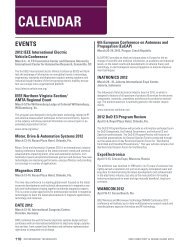2011 EMC Directory & Design Guide - Interference Technology
2011 EMC Directory & Design Guide - Interference Technology
2011 EMC Directory & Design Guide - Interference Technology
Create successful ePaper yourself
Turn your PDF publications into a flip-book with our unique Google optimized e-Paper software.
testing & test equipment<br />
Hi g h P o w e r El e c t r o m a g n e t i c Thr e at s t o t h e Smart Grid<br />
[1,7]. Based on research performed over<br />
the years, it has been concluded that<br />
the E1 and E3 HEMP are the biggest<br />
concerns to the power system due to<br />
their high peak field levels and efficiency<br />
in coupling to power and control<br />
lines. They both have an area coverage<br />
that can exceed several thousand kilometers<br />
from a single burst.<br />
The concern is that these high-level<br />
electromagnetic fields and their area<br />
coverage will create simultaneous<br />
problems for computers and other electronic<br />
systems on the Earth’s surface,<br />
including the critical infrastructures<br />
(power, telecommunications, transportation,<br />
finance, water, food, etc.). This<br />
was the focus of the U.S. Congressional<br />
EMP Commission studies [8, 9].<br />
Figure 4. Indication of the area exposed to E1 HEMP from a high-altitude burst over the central<br />
United States for various burst altitudes given in km.<br />
EMI, RFI, <strong>EMC</strong> &<br />
RadaR TuRnTablEs<br />
STANDARD 5 YEAR WARRANTY<br />
ON ALL MACTON PRODUCTS!<br />
ing field levels of 50 kV/m within 10<br />
ns, the intermediate-time (E2) HEMP<br />
reaching 100 V/m between 1 microsecond<br />
and 1 second, and the late-time<br />
(E3) HEMP reaching 40 V/km for times<br />
between 1 and several hundred seconds<br />
Custom Engineered Antenna and Radar Profiling Positioning Equipment<br />
• Indoor and outdoor applications<br />
• systems ranging up to 60’ in diameter<br />
• 100–ton capacities<br />
• Variable speed control capabilities<br />
and positioning accuracy of ±0.001°<br />
• dozens of military and private<br />
contractor installations<br />
Extreme geomagnetic storm<br />
background<br />
The first two high-power threats and<br />
environments discussed above are<br />
man-made. There is, however, a natural<br />
environment known as an extreme<br />
geomagnetic storm that has strong<br />
similarities (spatial distribution and<br />
time variation) to the late-time (E3)<br />
portion of the HEMP [10]. Because of<br />
this, the protection methods are also<br />
very similar, although the specification<br />
levels of protective devices may<br />
vary. It should be noted that the term<br />
extreme geomagnetic storm is used<br />
here to indicate that the level of the<br />
storm exceeds the usual description by<br />
NOAA of a severe geomagnetic storm,<br />
which may occur more than once during<br />
a solar cycle (11 years). The extreme<br />
geomagnetic storm is defined as a 1 in<br />
100 year storm [8].<br />
In brief, a large increase in charged<br />
particles ejected from the Sun and into<br />
the solar wind can interact with the<br />
Earth’s magnetic field and produce a<br />
significant distortion of the geomagnetic<br />
field at the surface of the Earth.<br />
This rapid variation of the geomagnetic<br />
field (on the order of seconds to<br />
minutes) induces time varying electric<br />
fields in the Earth, which through<br />
the neutrals of transformers create<br />
time-varying (yet quasi-dc relative to<br />
60 Hz) currents in the high-voltage<br />
power network. These currents induce<br />
severe harmonics, increase inductive<br />
50 interference technology emc <strong>Directory</strong> & design guide <strong>2011</strong>


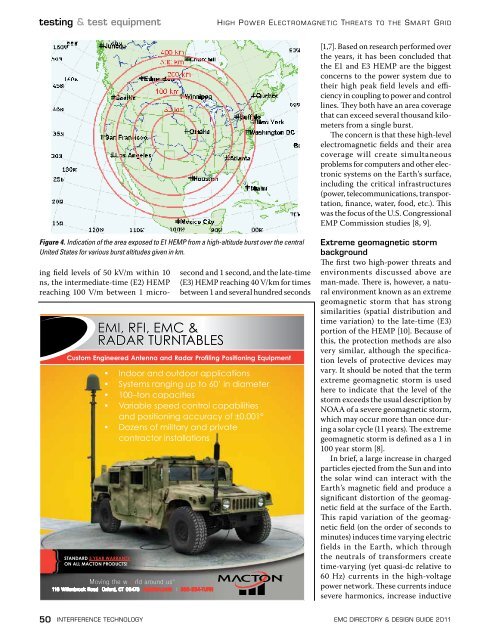

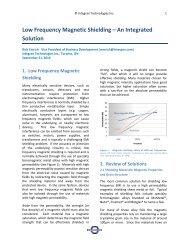

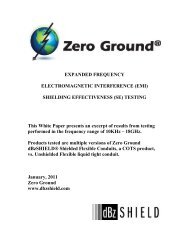
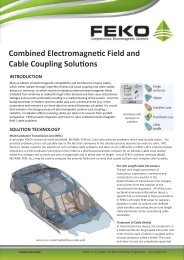



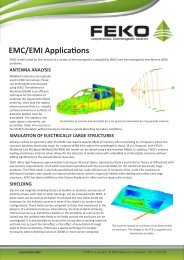
![[ thursday ] morning sessions 8:30 am-noon - Interference Technology](https://img.yumpu.com/23176841/1/190x247/-thursday-morning-sessions-830-am-noon-interference-technology.jpg?quality=85)
